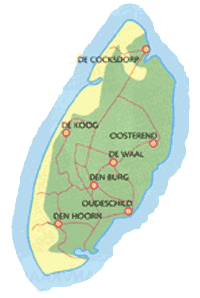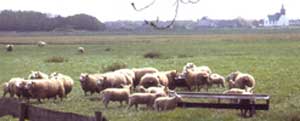General Information Texel
 Den Burg is the central town, with shops, a cinema and the town hall. Every Monday morning there is a market in the town centre.
Den Burg is the central town, with shops, a cinema and the town hall. Every Monday morning there is a market in the town centre.Den Hoorn, the southern-most village on Texel, lies at the rim of a vast dune landscape and in spring is surrounded by bulb fields in full bloom.
Texel's seaside resort is called De Koog. It is situated on the coast, ideal for many holidaymakers. You can have fun shopping and afterwards relax in one of the many outdoor cafés.
Oosterend is a picturesque village with many historical and carefully restored houses. Do explore the village on foot or by bike, because the streets are not suited to modern car traffic.
In Oudeschild it is mainly the ever lively harbour which attracts people. The modern cutter fleet is moored there every weekend. When the cutters sail in on Friday, the harbour is bustling with life.
De Cocksdorp is the youngest village. The entrance to the town is something special; the branches of the trees on either side of the Molenlaan have grown together in such a way, that they form a tunnel into the village.
Not far from Den Burg lies the small town of De Waal. In this cosy little village you will find many beautiful old houses and farmsteads.
 Whoever thinks of Texel, thinks of sheep. They are there by the thousands, and every spring their numbers are added to when thousands of lambs are born. Their wool is used in the famous duvets, among other things. Besides sheep there are thousands of cows roaming the Texel pastures.
Whoever thinks of Texel, thinks of sheep. They are there by the thousands, and every spring their numbers are added to when thousands of lambs are born. Their wool is used in the famous duvets, among other things. Besides sheep there are thousands of cows roaming the Texel pastures.The surface area of Texel is 145,060 acres. For the most part, this is water: 103,907 acres of sea water and 810 acres of inland waterways. This leaves a land mass of 40,347 acres. The island is over 20 kilometres long and on average over 8 kilometres broad. The Texel landscape is very varied.
Dunes and forests are interspersed with hilly landscapes and polder land. This variation in landscape reflects the situation in all of Holland. This impression is reinforced by the many nature reserves in between the man made landscapes. The island is inhabited by approximately 13,000 people, 3,500 of which make up the labour force. Of the labour force, 575 people, or seventeen per cent, are involved in agriculture.
The Slufter and the Muy are the best-known of all Texel nature reserves. The Slufter came into being when the dunes were breached in 1858 and it is still connected to the sea. When the tide is in, the salty sea water penetrates far into the dunes.
 It is best to explore Texel on foot or by bike. There are many facilities available for cyclists and walkers. There are 135 kilometres of cycling paths alone, for the most part separate from the road. In addition, there are of course many quiet roads, eminently suitable for bike tours. You can bring your own bike, but there are plenty of bikes for rent on Texel as well. The various bike hire firms are located all over the island. Some firms rent out tandems, ATBs, motorise bicycles and mopeds as well.
It is best to explore Texel on foot or by bike. There are many facilities available for cyclists and walkers. There are 135 kilometres of cycling paths alone, for the most part separate from the road. In addition, there are of course many quiet roads, eminently suitable for bike tours. You can bring your own bike, but there are plenty of bikes for rent on Texel as well. The various bike hire firms are located all over the island. Some firms rent out tandems, ATBs, motorise bicycles and mopeds as well.The 'Cycling and Walking Routes' booklet published by the Texel Tourist Information Office contains many suggestions for a pleasant trip on foot or by bike. In addition there are themed cycle routes: Nature (Thijsseroute), the Dutch East India Company, Art and the Department of Public Works. For those interested in longer walks, the 80 kilometres Texelpath has been signposted.
 The five Texel museums (Aviation Museum, Agricultural and Wagon Museum, EcoMare, Collection of Antiquities and the Maritime and Beachcombers Museum) can be visited at a discount with the CombiTicket. This ticket is available at the museums and the Tourist Information Office in Den Burg.
The five Texel museums (Aviation Museum, Agricultural and Wagon Museum, EcoMare, Collection of Antiquities and the Maritime and Beachcombers Museum) can be visited at a discount with the CombiTicket. This ticket is available at the museums and the Tourist Information Office in Den Burg.